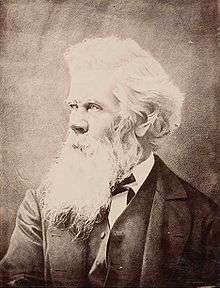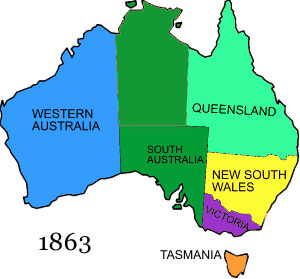Parkes ministry (1889–91)
| Fifth Parkes ministry | |
|---|---|
| 26th cabinet of the Colony of New South Wales | |
|
Premier Sir Henry Parkes and the Colony of New South Wales (1863–1900) | |
| Date formed | 8 March 1889 |
| Date dissolved | 22 October 1891 |
| People and organisations | |
| Head of government | Sir Henry Parkes |
| Head of state | Queen Victoria (represented by Lord Carrington and subsequently The Earl of Jersey) |
| Number of ministers | 10 |
| Member party | Free Trade Party |
| Status in legislature | Minority government |
| Opposition party | Protectionist Party |
| Opposition leader | George Dibbs |
| History | |
| Predecessor | Second Dibbs ministry |
| Successor | Third Dibbs ministry |
The fifth Parkes ministry was the 26th ministry of the Colony of New South Wales, and was led by the seventh Premier, the Honourable Sir Henry Parkes, GCMG. It was the fifth and final occasion that Parkes was Premier.[1]
Having served in the New South Wales Legislative Council between 1854 and 1856, Parkes was elected in the first free elections for the New South Wales Legislative Assembly held in 1856, however resigned from Parliament later that year. He served in the Assembly on several occasions, between 1858 and 1870, being forced to resign on at least one occasion due to his personal insolvency. He came to power as Premier on the first occasion in 1872, serving as Premier for a period of three years. However, Parkes lost the confidence of the Assembly following Governor Robinson's decision to release of the bushranger Frank Gardiner led to the defeat of the ministry in 1875.[2]
John Robertson served as Premier between 1875 and 1877, before Robertson was defeated at the 1877 election. Parkes formed his second ministry in a challenging environment where both Parkes and Robertson shared equal representation in the Legislative Assembly and business was sometimes at a standstill.[3] Parkes' second term as Colonial Premier lasted just 147 days, with the Farnell ministry giving both Parkes and Robertson reprieve for 12 months, prior to Parkes and Robertson forming an alliance government in the third Parkes ministry.[1] The retirement of Robertson pitted Parkes against George Dibbs and after the governments of both Dibbs and Sir Patrick Jennings faltered under public debt,[2] Parkes formed his fourth ministry, lasting nearly two years.
Dibbs again formed government, but lasted for less than two months, before Parkes again formed government, where he agitated for the formation of a Commonwealth of Australia against a somewhat hostile New South Wales Colonial government. When the New South Wales Legislative Assembly voted in favour of a motion of no confidence against Parkes, he resigned from Parliament in October 1891.[2][3]
There was no party system in New South Wales politics until 1887.[4] Under the constitution, ministers were required to resign to recontest their seats in a by-election when appointed.[5] In the table below, these by-elections are only noted when the minister was defeated; in general, he was elected unopposed.
This ministry covers the period from 8 March 1889 until 22 October 1891.[1]
Composition of ministry
| Portfolio | Minister | Party | Term start | Term end | Term length | |
|---|---|---|---|---|---|---|
| Premier Colonial Secretary Registrar of Records |
Hon. Sir Henry Parkes GCMG, MLA | Free Trade | 8 March 1889 | 22 October 1891 | 2 years, 227 days | |
| Colonial Treasurer Collector of Internal Revenue |
Hon. William McMillan MLA | Free Trade | 27 July 1891 | 2 years, 141 days | ||
| Hon. Bruce Smith MLA | Free Trade | 14 August 1891 | 22 October 1891 | 68 days | ||
| Attorney-General | Hon. George Simpson QC, MLC | Free Trade | 8 March 1889 | 2 years, 227 days | ||
| Secretary for Lands | Hon. James Brunker MLA | Free Trade | ||||
| Secretary for Public Works | Hon. Bruce Smith MLA | Free Trade | 13 August 1891 | 2 years, 158 days | ||
| Hon. James Young MLA | Free Trade | 14 August 1891 | 22 October 1891 | 68 days | ||
| Minister of Justice | Hon. Albert Gould MLA | Free Trade | 8 March 1889 | 2 years, 227 days | ||
| Minister of Public Instruction | Hon. Joseph Carruthers MLA | Free Trade | ||||
| Secretary for Mines | Hon. Sydney Smith MLA | Free Trade | ||||
| Secretary for Agriculture | 28 February 1890 | 2 years, 235 days | ||||
| Postmaster-General | Hon. Daniel O'Connor MLA | Free Trade | 8 March 1889 | 22 October 1891 | 2 years, 227 days | |
| Representative of the Government in Legislative Council | Hon. William Suttor, Jnr MLC | Free Trade | ||||
| Vice-President of the Executive Council | 30 April 1889 | 2 years, 174 days | ||||
See also
- Henry Parkes – seventh Premier of New South Wales
- Self-government in New South Wales
- Members of the New South Wales Legislative Assembly, 1887–1889
- First Parkes ministry (1872–1875)
- Second Parkes ministry (1877)
- Third Parkes ministry (1878–1883)
- Fourth Parkes ministry (1887–1889)
References
- 1 2 3 "Former Members - Chronological List of Ministries 1856 to 2009 (requires download)". Project for the Sesquicentenary of Responsible Government in NSW. Parliament of New South Wales. Archived from the original (Excel spreadsheet) on 15 March 2011. Retrieved 17 July 2011.
- 1 2 3 Martin, A. W. "Parkes, Sir Henry (1815–96)". Australian Dictionary of Biography. Australian National University. Retrieved 17 July 2011.
- 1 2 Serle, Percival. "Sir Henry Parkes (1816–1896)". Dictionary of Australian Biography. Project Gutenberg Australia. Retrieved 17 July 2011.
- ↑ Green, Antony (20 October 2010). "Centenary of the First NSW Labor Government". Australian Broadcasting Corporation. Archived from the original on 20 July 2011.
- ↑ "1904 Redistribution". Atlas of New South Wales. Government of New South Wales. Archived from the original on 20 July 2011.
| Preceded by Second Dibbs ministry |
Fifth Parkes ministry 1889–1891 |
Succeeded by Third Dibbs ministry |

